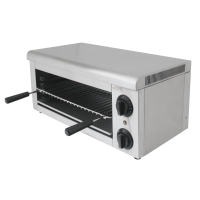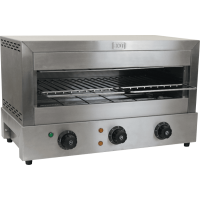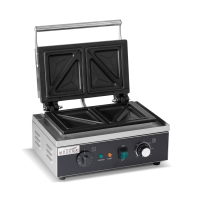Toaster Grills
Commercial toaster grills are the workhorses of cafés, delis, and restaurants across the UK, delivering crisp, perfectly toasted sandwiches and paninis in minutes. These robust units feature heavy-duty plates and adjustable temperature controls, providing versatility from warming baguettes to creating gourmet toasties with those satisfying grill marks customers love. Typically operating between 1.8-3kW, they're built specifically for continuous commercial use—far more durable than domestic sandwich toasters that wouldn't last a day in a busy kitchen. They pair brilliantly with commercial coffee machines for the complete café setup, or complement your griddles and hot plates for a versatile cooking station that keeps customers coming back!
Explore More About Toaster Grills
Get expert guidance, see real chef stories, and find answers to your most common questions.
-
Electric Salamander Toaster Grill | Commercial Salamander | 61cm Wide | Modena TG2
10 KGIn Stock
300H x 610W x 350D mm
13 amp plug fitted
Power Type: 220-240V 2.0 kW
Stainless Steel
£129.99 £337.00 -
Infrared Quartz Toaster Grill | Commercial Speed Toaster | Fast Heat Distribution | Modena IG1
10 KGIn Stock
350H x 580W x 350D mm
13 amp plug fitted
Shelf size: 240 x 480 mm
Stainless Steel
£189.99 £427.00 -
Commercial Sandwich Grill | Toastie Maker | Panini Press | Modena WF114
out of stock
220H x 390W x 360D mm
13 amp plug fitted
Temperature Range: 50-250°C
Stainless Steel
£144.99 £394.00
Commercial Toaster Grills for Cafés & Restaurants
Brands Trusted by Industry Professionals
Key Features and Benefits
- Adjustable Temperature Precise control from 50-300°C—perfect for everything from gentle warming to serious searing.
- Versatile Cooking Handles paninis, toasties, chicken, burgers, and vegetables—a true menu expander.
- Commercial-Grade Durability Reinforced hinges and heavy-duty plates withstand constant daily use.
- Rapid Heat Technology Reaches optimal temperature in minutes—keeps service moving.
- Even Heat Distribution Consistent results across the entire cooking surface—no cold spots.
- Non-Stick Surfaces Easy food release and quick clean-up between orders.
- Integrated Drip Trays Catches excess oils and fats—keeps your workspace clean.
- Long Service Life Built for years of reliable performance with minimal maintenance.
Too busy to read? Listen instead.
In this episode of The Deep Dive, we examine commercial toaster grills—from heavy-duty plate design and temperature control to tips for delivering consistent grill marks and optimal food texture under high-volume café conditions.
15.19min | Expert-led | Real-world advice
0:00: Welcome to the deep dive.
0:02: You sent us some really interesting stuff, basically, a detailed guide from a catering equipment expert, all focused on commercial toaster grills.
0:09: Yeah, fascinating material.
0:10: And you might think, OK, sandwich press, I know what that is, but these commercial ones, they seem to be, a completely different beast in cafes and restaurants.
0:21: Absolutely.
0:22: So our mission today is to unpack all that information you provided.
0:27: We want to get right to the heart of it, what these machines actually are, why they're so vital in, you know, food service, how they work their magic so fast, and really pull out the key features, the benefits, and, the things you really need to think.
0:41: about if you're looking at this kind of gear.
0:43: Exactly.
0:44: It looks simple on the surface, doesn't it?
0:46: But this deep dive should get you up to speed pretty quickly on the practical side and the, well, the surprisingly big impact they can have.
0:52: So let's just jump in.
0:53: What exactly are we talking about here?
0:55: What is a commercial toaster grill?
0:57: OK, so think of them as the real workhorses, especially for places like cafes, delis, busy restaurants, their main job.
1:05: To churn out perfectly crisp, perfectly toasted sandwiches, paninis, that sort of thing, but fast, consistently and under pressure workhorses.
1:16: That word immediately says, OK, this isn't like the one maybe gathering dust in my kitchen cupboard.
1:21: Definitely not.
1:22: What makes the commercial version so different?
1:24: That's probably the biggest takeaway right off the bat in the material.
1:28: The basic idea might be similar, yeah, but commercial units are built for a totally different world.
1:34: They're described as, far more durable, really robust things, heavy duty plates, precise temperature controls you can adjust.
1:41: They're just designed for nonstop heavy use.
1:45: Honestly, the source material basically says a domestic sandwich maker.
1:48: It.
1:49: Wouldn't last a single day in a busy kitchen.
1:51: Wouldn't last a day.
1:52: Well, that really puts it in perspective.
1:54: So incredibly tough.
1:55: What about power?
1:56: What kind of juice do they need for that workload?
1:58: Typically you're looking at somewhere between 1.8 and 3 kilowatts, which is, you know, a decent amount of power.
2:04: It's specifically geared for that consistent high volume output they need all day long.
2:09: Got it.
2:10: Serious power built like a tank.
2:13: So how do they actually, you know, do it?
2:16: How do they deliver that speed and consistency?
2:19: Well, the core idea is actually pretty simple but really effective.
2:23: You've got two heated plates, right, one top, one bottom.
2:26: They sandwich the food cooking both sides at the same time.
2:29: OK, 2 plates cooks both sides, simple enough.
2:33: What are these heavy duty plates actually made of?
2:35: The guide mentions they're usually either cast iron or they have non-stick coatings.
2:39: Right.
2:40: And they get seriously hot.
2:41: We're talking temperatures up to 300 °C.
2:44: 300 degrees.
2:45: That's a pretty intense heat.
2:48: How do they manage that?
2:49: Like, how do you cook a delicate cheese toastie versus something that needs a proper sear without just incinerating it?
2:56: that's where the precise temperature control is key.
2:58: They have thermostats built in, so the operator can set the exact heat they need, you know, anything from just gentle warming right up to that really high searing temperature.
3:07: And what about different thicknesses?
3:09: You know, a thin wrap versus a big chunky panini.
3:13: How does it cope?
3:14: Yeah, this is quite a clever bit of design they highlighted, the floating hinge, hinge.
3:21: Yeah, it basically adjusts automatically to whatever thickness you put in there.
3:26: So it makes sure you get even contact, even pressure across the whole surface of the food, no matter how thick or thin it is.
3:33: OK, so the hinge deals with the thickness variation.
3:36: And what actually happens when you clamp that lid down on, say, a panini, right, closing the lid does a couple of really important things.
3:43: First, that top plate pressing down.
3:46: That's what gives you those distinctive, really appealing grill marks.
3:51: The ones everyone likes, yeah, exactly.
3:53: But maybe more importantly for the taste, it helps seal in the moisture and the flavors inside the food.
4:00: And because you've got that direct heat from both sides, the cooking time is incredibly quick, usually like within 2 to 3 minutes, 2 to 3 minutes.
4:08: That's that's definitely a huge part of the whole workhorse thing, isn't it?
4:12: Let's dig into that why a bit more then.
4:15: What are the main features and benefits that make these so valuable commercially speaking?
4:19: Well, one of the biggest things that jumps out is just how versatile they are.
4:23: I mean, yes, they're brilliant for paninis and toasties, but they're much more than just sandwich machines.
4:29: That temperature control, going from 50 up to 300 degrees, it means you can use them for all sorts.
4:36: Gently warming pastries, searing chicken strips, cooking burgers, grilling vegetables.
4:42: They really let you expand your menu quite easily, so they can add completely new things to what a place offers and quickly too.
4:50: What about performance beyond just the speed?
4:53: Well, they talk about rapid heat technology, so they get up to cooking temperature really fast from cold, maybe just a few minutes, which is obviously vital for quick service.
5:01: Yeah, you can't be waiting around, and you also get really even heat across the plates.
5:04: No cold spots.
5:05: That means you get consistent results every single time.
5:08: And super important for the day to day grind, non-stick surfaces makes getting the food off easy and cleaning up much, much quicker.
5:16: Easy cleanup is always a winner in a busy kitchen.
5:20: We mentioned durability.
5:22: How long can a business actually expect one of these things to last?
5:26: The material really emphasizes that commercial grade toughness.
5:30: It mentions things like reinforced hinges, heavy duty plates, all built to just take constant use.
5:36: And a key point they make is that a quality model, you should expect it to last somewhere between 5 and 7 years, even in really high volume places, 5 to 7 years of heavy daily use.
5:47: That's pretty impressive.
5:48: Shows how they're built.
5:49: It really does.
5:50: What about efficiency?
5:51: Just from an operational point of view.
5:53: Well, that dual-sided cooking, it just inherently cuts your prep and cooking time in half for a lot of items, makes service way more efficient.
6:01: There was actually a great little did you know fact in there saying they can cook things up to 60% faster than a conventional oven.
6:08: 60%.
6:10: That's not just saving a bit of time.
6:12: That could completely change your workflow, especially at peak times.
6:15: Exactly.
6:16: And newer models are getting better with energy too.
6:18: Apparently they use about 15% less energy than older versions, which, you know, hits your running costs directly.
6:24: Faster cooking uses less energy.
6:27: Those are real tangible benefits for the bottom line.
6:31: How does using them actually affect the food quality?
6:35: And you know the business overall.
6:37: Well, this is where the way they cook really adds value, that quick sealing process.
6:41: It locks in moisture so things don't dry out, but you still get that lovely crisp texture on the outside.
6:47: That's both worlds, yeah, and this ability to take quite simple ingredients and turn them into what feels like a premium menu item.
6:55: Well, that can seriously boost profits.
6:58: I see.
6:59: It lets businesses charge a bit more for a hot, perfectly grilled sandwich than they could for just a cold one.
7:05: Turning simple stuff into premium items that fetch a better price.
7:08: Yeah, that's the business case right there, isn't it?
7:10: Pretty much.
7:11: OK, so say someone's listening, they see the benefits, and they're thinking about getting one.
7:16: What are the key things the guide says you need to consider when choosing?
7:19: First thing is capacity and size.
7:21: You've got to think about the plate dimensions.
7:23: You know, for a small cafe or maybe lower volume, a single grill, maybe with plates around 210 by 230 millimeters might be fine.
7:33: But if you're expecting.
7:35: output, you'd definitely be looking at the double models or the side by side ones.
7:39: So match the machine to your expected customer flow and your actual physical space.
7:45: Exactly.
7:45: And it's crucial to check your counter space, obviously, but also your electrical setup beforehand, right?
7:51: The electrics.
7:52: What kind of connection do they usually need?
7:54: Is it complicated?
7:56: Actually, most of them run on standard 13 amp plugs.
7:59: Oh, OK, like a kettle, yeah, pretty much, which makes them relatively easy to just plug in and go in most kitchens.
8:05: No special wiring needed usually.
8:07: Good to know.
8:08: Although the material does point out that the higher wattage models say 2.2 kilowatts end up, they tend to recover their heat faster, meaning after you put a cold sandwich on, they get back up to cooking temperature quicker, which is important if you're doing continuous cooking like during a really busy lunch.
8:24: Service.
8:25: , yeah, good point for those rush hours.
8:28: What about the plates themselves?
8:29: Are there different types of surfaces?
8:31: Yep, you generally find two main options ribbed plates or flat plates.
8:36: Ribbed plates, they give you those classic grill marks, and they can help drain away a bit of fat, which is sometimes good.
8:42: Flat plates, they give you full contact across the whole surface.
8:44: So that's great for really even browning, getting things like quesadillas or wraps, perfectly golden all over.
8:50: OK, so it kind of depends on the look you want and maybe what you're cooking most.
8:54: The material also briefly mentions some other types.
8:57: Yeah, just briefly, it's mentioned electric salamander grills and infrared quartz models as sort of variations or alternatives for certain jobs, just showing it's not only the contact grill style out there.
9:10: Interesting.
9:11: Good to know their options.
9:12: So who typically uses these machines?
9:14: Where are they really considered essential kit?
9:17: The guide is pretty clear on this cafes and delis, it calls them essential there.
9:22: Hotels use them a lot for breakfast, but often for all day menus too.
9:27: Sandwich shops obviously use them to offer hot options alongside cold ones, broadening their appeal, and food trucks love the compact models.
9:37: They don't take up much space, but let them offer a much wider range of hot food.
9:41: It really does sound like a fundamental bit of kit for pretty much any place wanting to serve hot food quickly.
9:46: The material even had a real world example, didn't it?
9:48: A success story.
9:49: It did, yeah, and it really shows the impact.
9:52: It was about a cafe in Bristol.
9:54: They were struggling a bit with their lunch rush.
9:57: Menu was a bit limited, so they decided to invest in a double commercial toaster grill.
10:02: OK.
10:02: And what happened after they got it?
10:04: It was apparently a total game changer for them.
10:07: They went from serving maybe 30 customers at lunchtime to over 80.
10:11: Wow, more than double, yeah.
10:13: The new hot sandwiches and paninis just transformed what they could offer.
10:17: So much so they started getting regulars coming in twice a day, not just for morning coffee anymore, but for lunch too.
10:23: That's incredible.
10:24: Overdoubling lunch customers just by adding that capability, that really shows the kind of concrete business impact we're talking about.
10:32: OK, let's switch gears slightly.
10:34: Let's talk about looking after these workhorses.
10:37: Keeping them running well and safely.
10:40: What practical tips did the guide offer?
10:42: Yeah, some really solid top tips for using them day to day.
10:46: Always preheat them properly, like 5 to 10 minutes before you start cooking.
10:50: Don't just chuck food on a cold grill.
10:51: Right, makes sense.
10:52: Best time to clean them is when they're still warm, but importantly not scalding hot.
10:58: Just use a damp cloth, wipe away any gunk before it bakes on hard, for really busy times using sandwich paper, you know, like parchment paper, between the food and the plate.
11:07: That can speed things up and keep the plates cleaner for longer between proper cleans.
11:12: Smart tip.
11:13: And if you have cast iron plates, they recommend seasoning them about once a month.
11:17: Just a light coat of oil helps maintain the nonstick and stops any rust.
11:21: Those sound like really practical maintenance points.
11:24: What about safety?
11:24: They get incredibly hot, as you said.
11:27: Absolutely crucial.
11:28: The safety guidelines section stress things like regularly checking the plates, the hinges, the power cords for any damage or wear and tear.
11:36: Always make sure the unit's on a stable level surface and keep it well away from any water.
11:41: Staff need to be really aware that the outside surfaces get extremely hot.
11:46: Signs are a good idea.
11:47: Yeah, definitely.
11:48: Always use the right tools, tongs, heat resistant gloves.
11:53: Don't try and grab hot food with your fingers.
11:55: So obvious, but easy mistake to make.
11:57: Exactly.
11:58: Also, switch it off when it's not being used for a while, saves energy, but it's also just safer, and then the standard electrical safety stuff, make sure it's properly earthed, avoid water getting anywhere near the plug or cable.
12:10: All really vital things to drum into staff in a busy kitchen.
12:14: The material also had some input from experts, didn't it, like Oliver Bennett and someone called Mark?
12:19: Yeah, Oliver Bennett, he's apparently a specialist in this kind of equipment.
12:22: He reinforced how useful things like adjustable heat zones are to stop things burning, and he really stressed energy efficiency, cleverly calling it key to toasting your profits, toasting your profits.
12:34: I like that.
12:35: Links the running costs right back to the machine's performance.
12:38: Yeah.
12:39: And then there was Mark who apparently has 5 decades, like 50 years of industry experience.
12:45: His view was very much about the long game.
12:48: He said a quality toaster grill isn't just buying something, it's an investment that really pays dividends over its working life, and he warned against going for the cheap option, said it might save cash initially, but almost always leads to more repair bills and costly downtime later on.
13:03: That sounds.
13:04: Like the voice of experience, doesn't it?
13:06: Yeah look beyond the initial price tag.
13:08: Think about reliability and the total cost over time.
13:12: Exactly.
13:12: It's about the value it delivers year after year, not just the upfront cost.
13:17: So if we were to quickly sum up the main pros and cons based on everything we've pulled out of this guide, well, the pros seem pretty compelling, especially for the right kind of place.
13:25: They're incredibly versatile, surprisingly easy to use day to day once you know how, and They have this really powerful knack for turning simple, fairly cheap ingredients into higher profit premium items people want.
13:39: The main con that kept coming up, they do need regular, careful cleaning.
13:42: You have to stay on top of it to keep them performing well, keep them hygienic, and stop flavors transferring between different foods.
13:49: But I guess for a business that's relying on them to churn out those hot items efficiently.
13:54: The upside, the operational speed, the menu boost, the profit, probably outweighs the cleaning tour.
14:01: Yeah, based on the material, it seems they quickly become pretty indispensable in those settings.
14:05: All right, well, we've certainly taken a deep dive into the world of commercial toaster grills there using that detailed guide you shared.
14:12: Yeah, we've seen how these, these workhorses are way more than just simple sandwich presses.
14:16: They're durable.
14:17: They're versatile, efficient machines that can really give a business a significant boost expanding menus, improving operations, directly helping the bottom line, like the Bristol Cafe example really showed.
14:28: Absolutely.
14:29: Hopefully this deep dive has quickly given you the key takeaways from that source material, you know, understanding what they are, how they manage that speed and versatility, why they're so important commercially, and the practical things to think about if you're choosing or using one.
14:45: And it does make you stop and think, doesn't it?
14:47: How one single, maybe often overlooked piece of kitchen kit like this, a real unsung hero, you could say.
14:55: Can have such a massive impact on a business's success, on the customer experience, turning basic stuff into profitable, popular items.
15:05: It really does.
15:06: It makes you wonder what other workhorse items, maybe in totally different fields are just as critical, but maybe fly under the radar a bit, something to ponder in your own line of work perhaps.
15:14: Indeed, definitely food for thought.
15:16: Well, thank you for sharing the sources for this deep dive.

Essential Buying Considerations
Capacity and Size
- Consider plate dimensions—210x230mm suits cafés with limited space.
- Double or side-by-side models offer greater output for busy venues.
- Check counter space and electrical layout before selecting larger units.
Power Source and Usage
- Most run on standard 13A plugs—easily integrates with existing setups.
- Higher wattage models (2.2kW+) deliver faster heat recovery times.
- Consider sandwich paper or non-stick spray for high-volume operations.
How Commercial Toaster Grills Work
Commercial toaster grills operate on a beautifully simple principle—two heated plates sandwich your food, cooking both sides simultaneously. Most models feature cast iron or non-stick plates that heat up to 300°C, with thermostats allowing precise temperature control depending on what you're cooking. The floating hinge design automatically adjusts to accommodate different food thicknesses, from slim toasties to bulging paninis. When you close the lid, the upper heating element presses down, creating those distinctive grill marks while sealing in flavours. Within 2-3 minutes, your sandwich emerges with a satisfying crisp exterior and perfectly melted filling—brilliant for handling those lunchtime queues!

Trusted Insights from Oliver Bennett
![]()
Commercial Catering Equipment Specialist
12+ years experience
Safety Guidelines
- Regular Inspection Check plates and cables for damage before each service.
- Stable Positioning Place on level surfaces away from water sources.
- Mind The Heat External surfaces become extremely hot—warn staff.
- Use Proper Tools Always handle food with tongs or heat-resistant gloves.
- Switch Off When Idle Turn off during quiet periods to save energy and extend lifespan.
- Electrical Safety Ensure proper earthing and avoid water contact with electrical components.
Top Tips for Using Commercial Toaster Grills
For optimal results, always preheat your grill for at least 5-10 minutes before the first service. Clean plates between uses with a damp cloth while still warm (not hot) to prevent food residue building up. For busy periods, consider using sandwich paper to speed up cleaning and prevent sticking. If your model has cast iron plates, season them monthly with a light coating of cooking oil to maintain their non-stick properties and prevent rusting.
Benefits of Using Commercial Toaster Grills
- Enhanced Flavour Seals in moisture while creating crisp exteriors—customers notice the difference.
- Efficient Service Dual-sided cooking cuts preparation time in half—perfect for busy periods.
- Menu Versatility Transforms simple ingredients into premium menu items—boosts profits.
Did You Know?
- Speed Commercial toaster grills cook 60% faster than conventional ovens—UK café tested.
- Longevity Quality models last 5-7 years in high-volume environments.
- Versatility Beyond sandwiches, they're brilliant for vegetables, chicken, and even desserts.
- Efficiency Modern toaster grills use 15% less energy than older models—saves costs.




Expert Insights on Commercial Toaster Grills
After five decades supplying kitchens across the UK, we've seen these grills transform café operations. 'A quality toaster grill is an investment that pays dividends,' explains Mark, our equipment specialist. 'The cheaper models might save you money upfront, but the repair costs and downtime will hurt your business long-term.'
- Pros: Versatile, easy to operate, transforms simple ingredients into premium menu items.
- Cons: Requires regular cleaning to maintain non-stick properties and avoid flavour transfer.
Who Needs Commercial Toaster Grills?
- Cafés & Delis Essential for delivering hot paninis and toasties throughout the day.
- Hotels Perfect for breakfast services and all-day dining menus.
- Sandwich Shops Transforms your menu from cold options to premium hot offerings.
- Food Trucks Compact models maximise limited space while expanding menu options.

Real-World Success with Commercial Toaster Grills
A small but ambitious café in Bristol was struggling with lunchtime rushes and limited menu options. After investing in a double commercial toaster grill and pairing it with their existing coffee machine setup, they completely transformed their operation. 'We've gone from serving 30 customers during lunch to over 80,' says the owner. 'Our new hot sandwich menu has been a game-changer—we're seeing regular customers twice a day now instead of just for morning coffee.'

FAQs
- What's the best way to clean a commercial toaster grill? Clean plates while warm with a damp cloth—never use abrasives on non-stick surfaces.
- How long should a commercial toaster grill last? Quality models typically last 5-7 years in busy environments with proper maintenance.
- Can I cook raw meat on a toaster grill? Yes, but ensure internal temperatures reach food safety standards—ideal for thin cuts.
- What's the difference between ribbed and flat plates? Ribbed creates grill marks and drains fat; flat provides more contact for even browning.
- Are commercial toaster grills energy-efficient? Modern models are designed for efficiency—many feature insulated bodies to retain heat.
- Can I use a commercial toaster grill for breakfast service? Absolutely—brilliant for toasted sandwiches, bacon, and even pancakes.
Looking for Equipment by Business Type?
Not sure where to start? Whether you're running a bustling café, opening a pizzeria, or managing a school canteen, we've made it easy to shop by business type. Explore handpicked equipment bundles and essentials tailored to your industry—saving you time and making sure you get exactly what you need.
Other Categories You Might Find Useful
We’ve selected some closely related categories that might be essential for your setup. Whether you’re expanding your kitchen or just making sure you’ve got everything covered, these links will help you explore more equipment that fits your needs.
What our Customers Say
'This toaster grill has doubled our lunchtime sales—absolute game-changer!'
M Michael Sandwich Bar Owner, Leeds'Heats quickly and cleans easily—worth every penny for our busy café.'
L Laura Bistro Manager, Glasgow
Why Choose EasyEquipment for Commercial Toaster Grills?
- 50 Years of Expertise Half a century helping cafés and restaurants find the perfect kit.
- Next-Day Delivery Order before 2pm for next-day service across the UK mainland.
- Price Match Guarantee Found it cheaper? We'll match any legitimate price—no quibble.
- Lifetime Technical Support Our experts are a phone call away—even years after purchase.
Ready to Explore Commercial Toaster Grills?
Browse our comprehensive range of commercial toaster grills, with options to suit every café, restaurant or food truck. With our expertise and support, you'll find the perfect model to elevate your menu and boost your business!
#CommercialToasterGrill
- #PaniniPress
- #CafeEquipment
- #RestaurantKit
- #SandwichToaster
- #EasyEquipment
- #UKCatering



